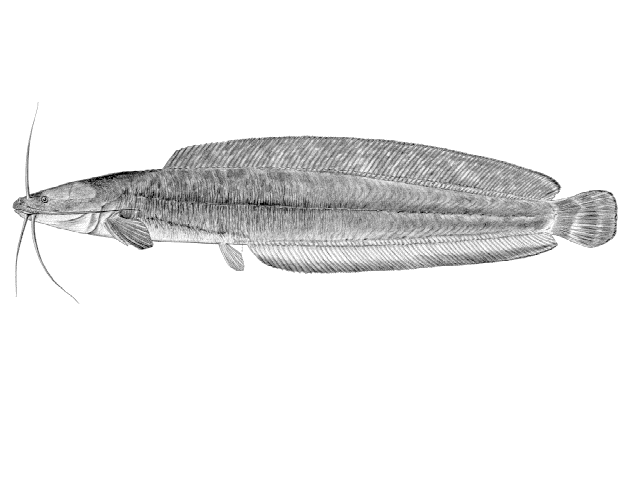
|
Clarias theodorae Weber, 1897 Snake catfish |

|
|
photo by
Mertens, P. |
| Family: | Clariidae (Airbreathing catfishes) | |||
| Max. size: | 35 cm SL (male/unsexed) | |||
| Environment: | demersal; freshwater, | |||
| Distribution: | Africa: Zambezi, Kafue and Shire Rivers; Upper Congo system; Lakes Tanganyika, Bangweulu, Kobo, Niumbe, Mweru and Malawi; Chobe, Okavango and Cunene Rivers; Pungwe, Sabi, Lundi Rivers and Zimbabwean tributaries of the Limpopo River; Incomati, Pongolo and Umgeni rivers and Lake Sibaya in Natal and Transvaal tributaries of the Limpopo (Ref. 3820). Also in the middle Congo (Ref. 106245), including the Ubangi (Ref. 248) and several southern tributaries of the Kasai (Ref. 248, 11970) and in the Cuanza in Angola (Ref. 120641). | |||
| Diagnosis: |
Dorsal spines (total): 0-0; Dorsal soft rays (total): 71-94; Anal soft rays: 60-89; Vertebrae: 56-61. Diagnosis: Head rectangular in dorsal outline; snout broadly rounded; eyes dorsally located; frontal fontanelle `knife-shaped'; occipital fontanelle very long and oval-shaped; the `dermosphenotic' and supraorbital bones become joined in specimens of 80-90 mm standard length; tooth plates relatively small; dorsal and anal fins not confluent with caudal fins; gill rakers relatively long, slender and distantly set; openings of the secondary sensory canals arranged in regular pattern on the flanks (Ref. 248). Characterised by a relatively small, short head, 4-5 times in standard length, long barbels reaching to behind the head, and an elongated slender body with a long anal fin (Ref. 52193). Description: Dorsal fin with 71-94 rays; anal fin with 60-89 rays; pectoral fin spine with barbs along outer and inner edges; origin of anal fin nearer tip of snout than base of caudal fin (Ref. 52193). Gill rakers spaced, 13-19 on first gill arch; suprabranchial organ reduced, not filling chamber, with thick stubby branches (Ref. 52193). Colouration: Usually mottled, black or dark brown; lateral line may be marked in white (Ref. 52193). |
|||
| Biology: | Lives in vegetated areas in shallow and swampy places around the lake. Occasionally found in cataracts, hiding under rocks (Ref. 248). The species is omnivorous (Ref. 78218) and feeds on insects (Coleoptera, ants, Chironomid larvae) (Ref. 248 & 5595), plant seeds and other fishes (Ref. 78218). | |||
| IUCN Red List Status: | Least Concern (LC); Date assessed: 20 June 2018 Ref. (130435) | |||
| Threat to humans: | harmless | |||